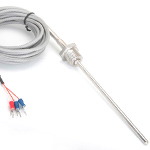pt100 platinum thermal resistance
- Stable quality: implement process quality control, pay attention to quality, and test in many aspects!
- Reasonable price: effective internal cost control, cost reduction and customer service!
- Quick delivery: perfect production line, sufficient inventory and shortened delivery time!
- Tel:86-0550-2406812
- Mobile phone:17856844858
- E-mail:13605508812@139.com
Description
 The resistance of t100 platinum thermal resistance is proportional to the change of temperature. The relationship between the resistance value of PT100 and the temperature change is: when the temperature of PT100 is 0°C, its resistance value is 100 ohms, and its resistance value is about 138.5 ohms at 100°C. Its industrial principle: when the PT100 is at 0 degrees Celsius, its resistance value is 100 ohms, and its resistance value will increase at a uniform rate as the temperature rises. The resistance value and temperature of a metal thermal resistor can generally be expressed by the following approximate relational formula, namely Rt=Rt0[1+α(t-t0)] where Rt is the resistance value at temperature t; Rt0 is temperature t0 (usually t0=0℃) corresponds to the resistance value; α is the temperature coefficient.
The resistance of t100 platinum thermal resistance is proportional to the change of temperature. The relationship between the resistance value of PT100 and the temperature change is: when the temperature of PT100 is 0°C, its resistance value is 100 ohms, and its resistance value is about 138.5 ohms at 100°C. Its industrial principle: when the PT100 is at 0 degrees Celsius, its resistance value is 100 ohms, and its resistance value will increase at a uniform rate as the temperature rises. The resistance value and temperature of a metal thermal resistor can generally be expressed by the following approximate relational formula, namely Rt=Rt0[1+α(t-t0)] where Rt is the resistance value at temperature t; Rt0 is temperature t0 (usually t0=0℃) corresponds to the resistance value; α is the temperature coefficient.
The relationship between the resistance and temperature of the semiconductor thermistor is: Rt=AeB/t where Rt is the resistance when the temperature is t; A and B depend on the constant of the structure of the semiconductor material. In comparison, the thermistor has a larger temperature coefficient and a higher resistance value at room temperature (usually more than several thousand ohms), but the interchangeability is poor, the nonlinearity is serious, and the temperature measurement range is only -50~300℃ It is widely used in temperature detection and control for home appliances and automobiles. Metal thermal resistance is generally suitable for temperature measurement in the range of -200~500℃. It is characterized by accurate measurement, good stability, reliable performance, and extremely wide application in process control.


